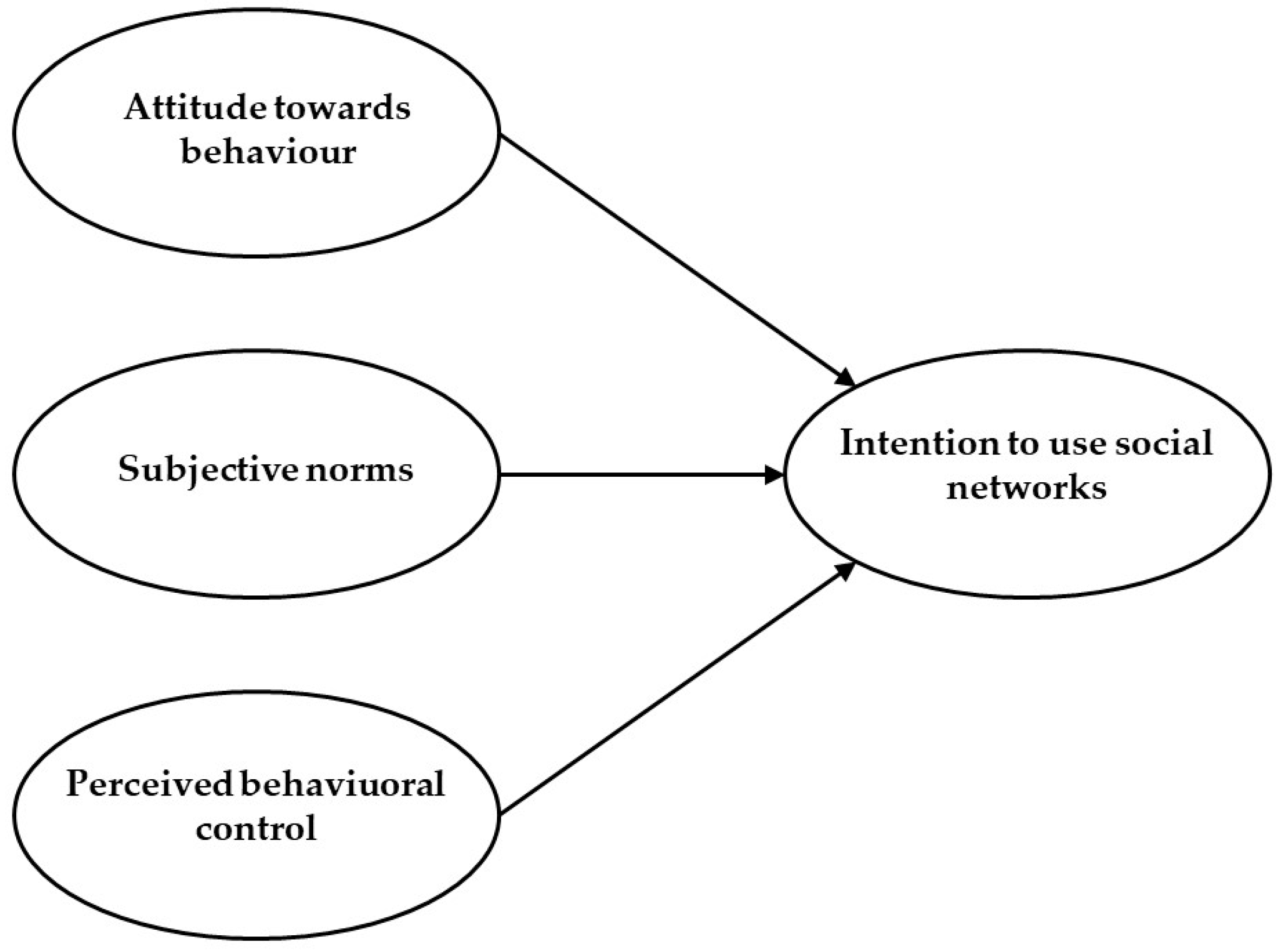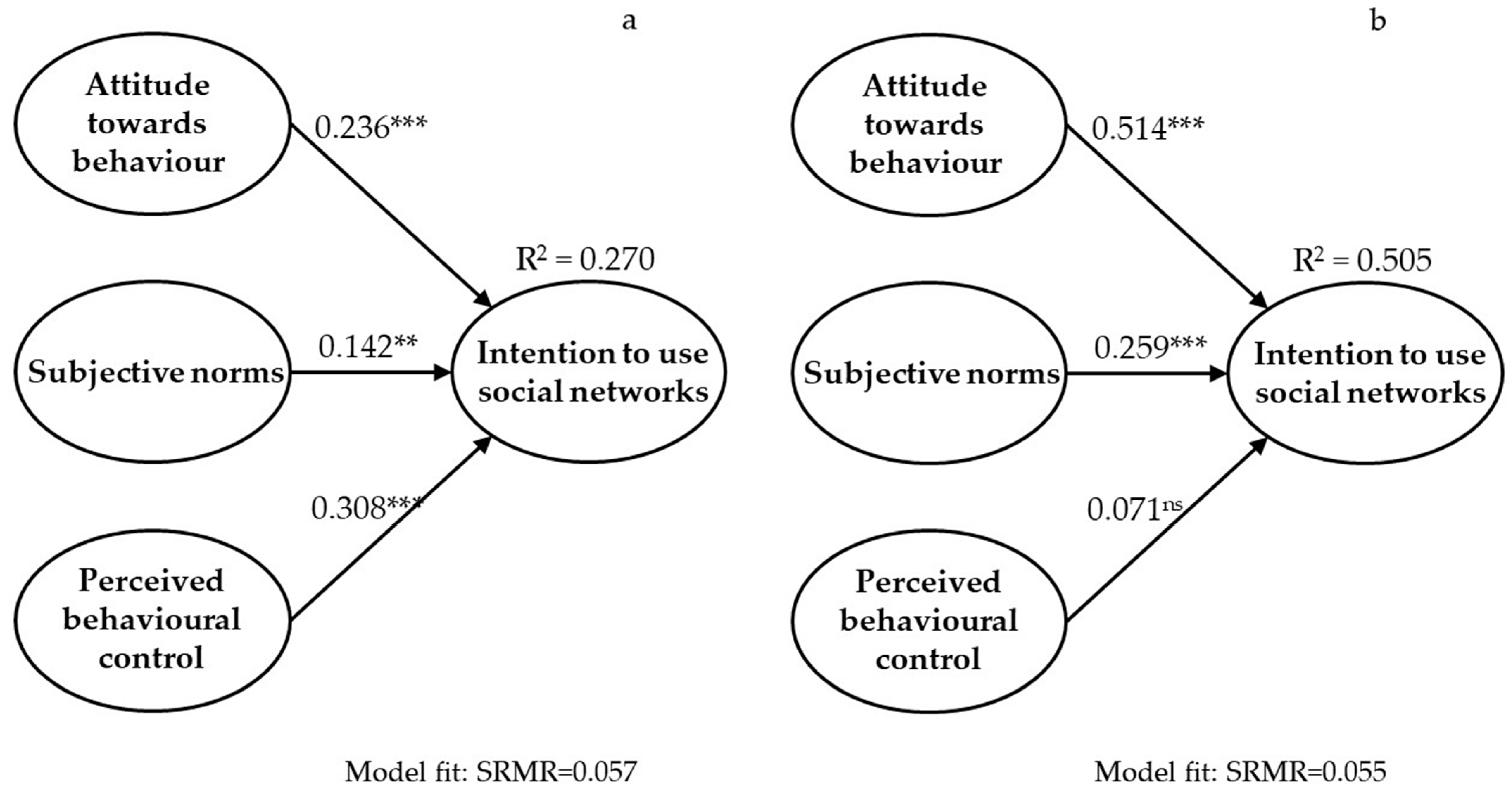Acceptance of Social Networking Sites by Older People before and after COVID-19 Confinement: A Repeated Cross-Sectional Study in Chile, Using the Theory of Planned Behaviour (TPB)
Abstract
1. Introduction
2. Materials and Methods
2.1. Design and Sample
2.2. Measurements
2.3. Data collection and Data Analysis
3. Results
3.1. Characteristics of the Participants
3.2. Structural Models
3.3. Multigroup Analysis (MGA)
4. Discussion
5. Conclusions
Supplementary Materials
Author Contributions
Funding
Institutional Review Board Statement
Informed Consent Statement
Data Availability Statement
Acknowledgments
Conflicts of Interest
References
- Marston, H.R.; Musselwhite, C.B.A. Improving Older People’s Lives Through Digital Technology and Practices. Aging Technol.-Editor. Gerontol. Geriatr. Med. 2021, 7, 1–4. [Google Scholar] [CrossRef] [PubMed]
- Liu, L.; Wu, F.; Tong, H.; Hao, C.; Xie, T. Active Aging in China. Int. J. Environ. Res. Public Health 2021, 18, 12675. [Google Scholar] [CrossRef] [PubMed]
- Subsecretaría de Telecomunicaciones. IX Encuesta Acceso y Usos Internet, 2017; Subtel: Saniago, Chile, 2017. [Google Scholar]
- Ramírez-Correa, P.; Painén-Aravena, G.; Alfaro-Peréz, J.; Mariano, A.M.; Machorro-Ramos, F. Hedonic motivations for social networking sites use by elderly: An exploratory study in Chile. Iber. J. Inf. Syst. Technol. 2019, 17, 563–570. [Google Scholar]
- VTR y Criteria Research. Informe Digitaclización Personas Mayores; VTR y Criteria Research: Santiago de Chile, Chile, 2021; Available online: https://www.anda.cl/wp-content/uploads/2021/09/Informe-personas-mayores-2021-VTR.pdf (accessed on 3 August 2022).
- Bass, F.M. A New Product Growth for Model Consumer Durables. Manag. Sci. 1969, 15, 215–227. Available online: https://www.jstor.org/stable/2628128 (accessed on 22 September 2022). [CrossRef]
- Nolan, R.L. Managing the Computer Resource: A Stage Hypothesis. Manag. Data Base Syst. 1973, 16, 399–405. [Google Scholar] [CrossRef]
- Karahanna, E.; Straub, D.W.; Chervany, N.L. Information technology adoption acrross time: A cross-sectional comparison of pre-adoption and post-adoption biliefs. MIS Q. 1999, 23, 183–213. [Google Scholar] [CrossRef]
- Ajzen, I. The Theory of Planned Behavior. Organ. Behav. Hum. Decis. Processes 1991, 50, 179–211. [Google Scholar] [CrossRef]
- Plotnikoff, R.C.; Lubans, D.R.; Trinh, L.; Craig, C.L. A 15-year longitudinal test of the theory of planned behaviour to predict physical activity in a randomized national sample of Canadian adults. Psychol. Sport Exerc. 2012, 13, 521–527. [Google Scholar] [CrossRef]
- Leung, X.Y. Do destination Facebook pages increase fan’s visit intention? A longitudinal study. J. Hosp. Tour. Technol. 2019, 10, 205–218. [Google Scholar] [CrossRef]
- Roux, L.; Gourlan, M.; Cousson-Gélie, F. A longitudinal test of the theory of planned behaviour to explain physical activity level in children: Exploration of the role of gender and age. Psychol. Health 2021, 36, 685–700. [Google Scholar] [CrossRef]
- Thaker, J.; Ganchoudhuri, S. The role of attitudes, norms, and efficacy on shifting COVID-19 vaccine intentions: A longitudinal study of COVID-19 vaccination intentions in New Zealand. Vaccines 2021, 9, 1132. [Google Scholar] [CrossRef]
- Liu, K.; Or, C.K.; So, M.; Cheung, B.; Chan, B.; Tiwari, A.; Tan, J. A longitudinal examination of tablet self-management technology acceptance by patients with chronic diseases: Integrating perceived hand function, perceived visual function, and perceived home space adequacy with the TAM and TPB. Appl. Ergon. 2022, 100, 103667. [Google Scholar] [CrossRef]
- Pan, X. Repeated Cross-Sectional Design. In Encyclopedia of Gerontology and Population Aging; Springer International Publishing: Berlin/Heidelberg, Germany, 2021; pp. 4246–4250. [Google Scholar]
- Kwon, S.J.; Park, E.; Kim, K.J. What drives successful social networking services? A comparative analysis of user acceptance of Facebook and Twitter. Soc. Sci. J. 2014, 51, 534–544. [Google Scholar] [CrossRef]
- Sun, Y.; Liu, L.; Peng, X.; Dong, Y.; Barnes, S.J. Understanding Chinese users’ continuance intention toward online social networks: An integrative theoretical model. Electron. Mark. 2014, 24, 57–66. [Google Scholar] [CrossRef]
- Venkatesh, V.; Thong, J.Y.L.; Xu, X. Consumer acceptance and use of information technology: Extending the unified theory of acceptance and use of technology. MIS Q. 2012, 36, 157–178. [Google Scholar] [CrossRef]
- Venkatesh, V.; Morris, M.G.; Davis, G.B.; Davis, F.D. User Acceptance of Information Technology: Toward a Unified View. MIS Q. 2003, 27, 425–478. [Google Scholar] [CrossRef]
- Hair, J.F., Jr.; Hult, G.T.M.; Ringle, C.M.; Sarstedt, M. A Primer on Partial Least Squares Structural Equation Modeling (Pls-Sem); SAGE Publications, Inc.: Thousand Oaks, CA, USA, 2014; Available online: https://books.google.de/books?id=Xn-LCwAAQBAJ&dq=A+primer+on+partial+least+squares+structural+equation+modeling+(PLS-SEM)&lr=&source=gbs_navlinks_s (accessed on 22 September 2022).
- Roemer, E. A tutorial on the use of PLS path modeling in longitudinal studies. Ind. Manag. Data Syst. 2016, 116, 1901–1921. [Google Scholar] [CrossRef]
- Henseler, J. PLS-MGA: A Non-Parametric Approach to Partial Least Squares-based Multi-Group Analysis. In Challenges at the Interface of Data Analysis, Computer Science, and Optimization; Springer: Berlin/Heidelberg, Germany, 2012; pp. 495–501. [Google Scholar]
- Henseler, J.; Ringle, C.M.; Sarstedt, M. Testing measurement invariance of composites using partial least squares. Int. Mark. Rev. 2016, 33, 405–431. [Google Scholar] [CrossRef]
- Ringle, C.M.; Wende, S.; Becker, J.-M. SmartPLS 3; SmartPLS: Bönningstedt, Germany, 2015. [Google Scholar]
- Baggozzi, R.P.; Yi, Y.; Phillips, L.W. Assessing construct validity in organizational research. Adm. Sci. Q. 1991, 36, 421–458. [Google Scholar] [CrossRef]
- Kock, N.; Hadaya, P. Minimum sample size estimation in PLS-SEM: The inverse square root and gamma-exponential methods. Inf. Syst. J. 2018, 28, 227–261. [Google Scholar] [CrossRef]
- Gibson, L.P.; Magnan, R.E.; Kramer, E.B.; Bryan, A.D. Theory of Planned Behavior Analysis of Social Distancing during the COVID-19 Pandemic: Focusing on the Intention-Behavior Gap. Ann. Behav. Med. 2021, 55, 805–812. [Google Scholar] [CrossRef]
- Yu, J.; Ha, I.; Choi, M.; Rho, J. Extending the TAM for a t-commerce. Inf. Manag. 2005, 42, 965–976. [Google Scholar] [CrossRef]
- Ng, B.P.; Park, C.; Silverman, C.L.; Eckhoff, D.O.; Guest, J.C.; Díaz, D.A. Accessibility and utilisation of telehealth services among older adults during COVID-19 pandemic in the United States. Health Soc. Care 2022, 30, e2657–e2669. [Google Scholar] [CrossRef]
- Yu, E.; Hagens, S.; Canada Health Infoway. Socioeconomic Disparities in the Demand for and Use of Virtual Visits Among Senior Adults During the COVID-19 Pandemic: Cross-sectional Study. JMIR Ageing 2022, 5, e35221. [Google Scholar] [CrossRef]
- Wong, A.; Ho, S.; Olusanya, O.; Antonini, M.V.; Lyness, D. The use of social media and online communications in times of pandemic COVID-19. J. Intensive Care Soc. 2021, 22, 255–260. [Google Scholar] [CrossRef]
- Bastani, P.; Mohammadpour, M.; Samadbeik, M.; Bastani, M.; Rossi-Fedele, G.; Balasubramanian, M. Factors influencing access and utilization of health services among older people during the COVID-19 pandemic: A scoping review. Arch. Public Health 2021, 79, 190. [Google Scholar] [CrossRef]
- Choukou, M.A.; Sanchez-Ramirez, D.C.; Pol, M.; Uddin, M.; Monnin, C.; Syed-Abdul, S. COVID-19 infodemic and digital health literacy in vulnerable populations: A scoping review. Digit. Health 2022, 8, 1–13. [Google Scholar] [CrossRef]
- Gould, C.E.; Carlson, C.; Alfaro, A.J.; Chick, C.F.; Bruce, M.L.; Forman-Hoffman, V.L. Changes in Quality of Life and Loneliness Among Middle-Aged and Older Adults Participating in Therapist-Guided Digital Mental Health Intervention. Front. Public Health 2021, 9, 746904. [Google Scholar] [CrossRef]
- Wong, F.H.C.; Leung, D.K.Y.; Wong, E.L.Y.; Liu, T.; Lu, S.; Chan, O.F.; Wong, G.H.Y.; Lum, T.Y.S. The Moderating Role of Community Capacity for Age-friendly Communication in Mitigating Anxiety of Older Adults During the COVID-19 Infodemic: Cross-sectional Survey. JMIR Infodemiol. 2022, 2, e33029. [Google Scholar] [CrossRef]
- Graham, S.A.; Stein, N.; Shemaj, F.; Branch, O.H.; Paruthi, J.; Kanick, S.C. Older Adults Engage with Personalized Digital Coaching Programs at Rates That Exceed Those of Younger Adults. Front. Digit. Health 2021, 3, 642818. [Google Scholar] [CrossRef]
- Sarstedt, M.; Ringle, C.M.; Hair, J.F. Partial Least Squares Structural Equation Modeling. In Handbook of Market Research; Springer: Cham, Switzerland, 2020; pp. 1–40. [Google Scholar]


| Age | T1: Before Confinement | T2: After Confinement | ||||
|---|---|---|---|---|---|---|
| Women | Men | n (%) | Women | Men | n (%) | |
| 60–69 | 128 | 104 | 232 (60.4) | 121 | 107 | 228 (59.5) |
| 70–79 | 72 | 53 | 125 (32.6) | 66 | 50 | 116 (30.4) |
| 80+ | 15 | 12 | 27 (7.0) | 26 | 13 | 39 (10.2) |
| Total (%) | 215 (56.0) | 169 (44.0) | 384 (100.0) | 213 (55.6) | 170 (44.4) | 383 (100.0) |
| Path | T1: Before Confinement | T2: After Confinement | ||||||
|---|---|---|---|---|---|---|---|---|
| ß | p-Value | Confidence Interval Corrected for ß Bias | ß | p-Value | Confidence Interval Corrected for ß Bias | |||
| 2.5% | 97.5% | 2.5% | 97.5% | |||||
| Attitude towards behaviour ⇒ Intention to use social networks | 0.236 *** | 0.000 | 0.109 | 0.360 | 0.514 *** | 0.000 | 0.419 | 0.601 |
| Subjective Norms ⇒ Intention to use social networks | 0.142 ** | 0.007 | 0.042 | 0.246 | 0.259 *** | 0.000 | 0.174 | 0.345 |
| Perceived behavioural control ⇒ Intention to use social networks | 0.308 *** | 0.000 | 0.185 | 0.425 | 0.071 ns | 0.097 | −0.019 | 0.151 |
| Composite (Step 2) | Correlation Value | 5.0% Quintile | Permutation (p-Values) | Composite Invariance | ||||||
|---|---|---|---|---|---|---|---|---|---|---|
| Attitude towards behaviour | 0.999 | 0.995 | 0.392 | Yes | ||||||
| Intention to use social networks | 1.000 | 1.000 | 0.421 | Yes | ||||||
| Perceived behavioural control | 1.000 | 0.989 | 0.951 | Yes | ||||||
| Subjective norm | 1.000 | 0.998 | 0.628 | Yes | ||||||
| Measurement Invariance (Step 3) | Mean diffs. | 2.5% | 97.5% | p | Variance diffs. | 2.5% | 97.5% | p | EM | MI |
| Attitude towards behaviour | −0.014 | −0.145 | 0.137 | 0.845 | 0.123 | −0.298 | 0.298 | 0.461 | Yes | Full |
| Intention to use social networks | 0.216 | −0.135 | 0.158 | 0.006 | −0.049 | −0.358 | 0.329 | 0.776 | No | Partial |
| Perceived behavioural control | 0.381 | −0.145 | 0.132 | 0.000 | −0.120 | −0.266 | 0.252 | 0.360 | No | Partial |
| Subjective norm | 0.070 | −0.145 | 0.145 | 0.353 | 0.012 | −0.231 | 0.225 | 0.900 | Yes | Full |
| Path | T1 vs. T2 | |
|---|---|---|
| ß1–ß2 | p-Value | |
| Attitude towards behaviour > Intention to use social networks | −0.278 ** | 0.001 |
| Subjective Norm > Intention to use social networks | −0.118 ns | 0.086 |
| Perceived behavioural control > Intention to use social networks | 0.237 ** | 0.003 |
Publisher’s Note: MDPI stays neutral with regard to jurisdictional claims in published maps and institutional affiliations. |
© 2022 by the authors. Licensee MDPI, Basel, Switzerland. This article is an open access article distributed under the terms and conditions of the Creative Commons Attribution (CC BY) license (https://creativecommons.org/licenses/by/4.0/).
Share and Cite
Ramírez-Correa, P.; Grandón, E.; Arenas-Gaitán, J.; Rondán-Cataluña, J.; Ramírez-Santana, M. Acceptance of Social Networking Sites by Older People before and after COVID-19 Confinement: A Repeated Cross-Sectional Study in Chile, Using the Theory of Planned Behaviour (TPB). Int. J. Environ. Res. Public Health 2022, 19, 13355. https://doi.org/10.3390/ijerph192013355
Ramírez-Correa P, Grandón E, Arenas-Gaitán J, Rondán-Cataluña J, Ramírez-Santana M. Acceptance of Social Networking Sites by Older People before and after COVID-19 Confinement: A Repeated Cross-Sectional Study in Chile, Using the Theory of Planned Behaviour (TPB). International Journal of Environmental Research and Public Health. 2022; 19(20):13355. https://doi.org/10.3390/ijerph192013355
Chicago/Turabian StyleRamírez-Correa, Patricio, Elizabeth Grandón, Jorge Arenas-Gaitán, Javier Rondán-Cataluña, and Muriel Ramírez-Santana. 2022. "Acceptance of Social Networking Sites by Older People before and after COVID-19 Confinement: A Repeated Cross-Sectional Study in Chile, Using the Theory of Planned Behaviour (TPB)" International Journal of Environmental Research and Public Health 19, no. 20: 13355. https://doi.org/10.3390/ijerph192013355
APA StyleRamírez-Correa, P., Grandón, E., Arenas-Gaitán, J., Rondán-Cataluña, J., & Ramírez-Santana, M. (2022). Acceptance of Social Networking Sites by Older People before and after COVID-19 Confinement: A Repeated Cross-Sectional Study in Chile, Using the Theory of Planned Behaviour (TPB). International Journal of Environmental Research and Public Health, 19(20), 13355. https://doi.org/10.3390/ijerph192013355







